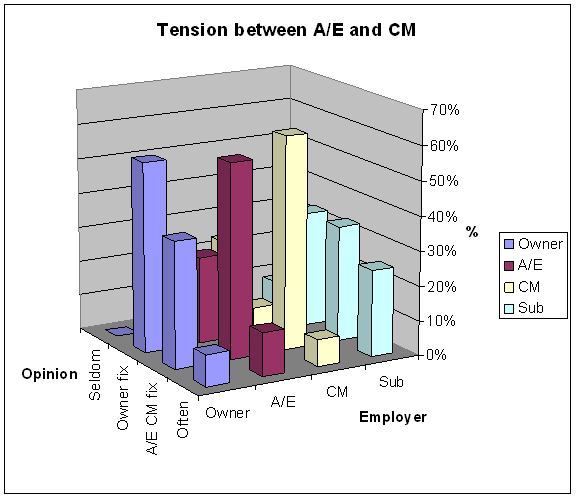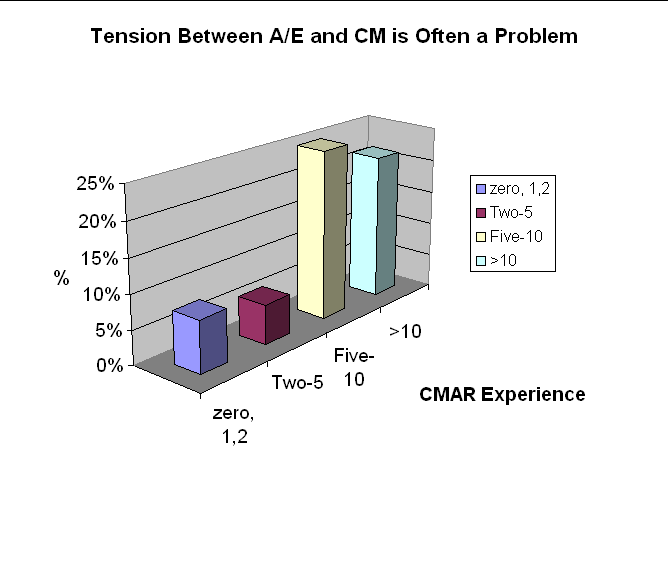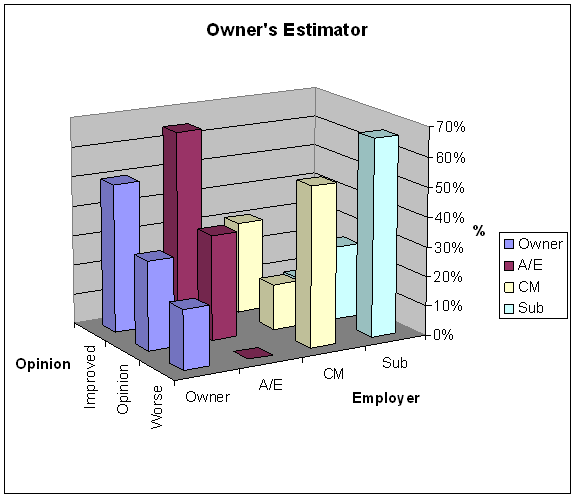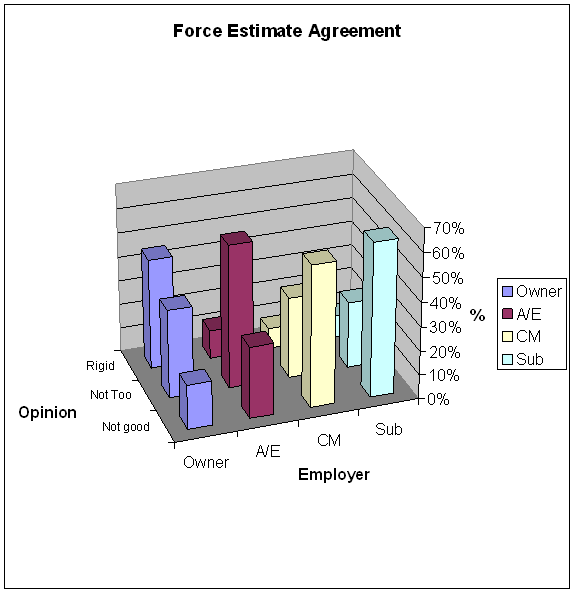Scope and Budget
There is tension between the parties relating to scope and budget during preconstruction, and a third-party estimator and reconciliation of estimates between A/E and CM may not relieve this tension. Owners, A/E, and CMs disagree on how to handle this tension
Summary
There is tension during the preconstruction phase between the parties, especially A/Es on one hand and CMs and Subs on the other hand, regarding scope and budget. This tension is usually worked out before it becomes a “problem,” although the parties disagree who works it out; Owners believe they do, while A/Es, CMs, and Subs believe the team works it out. Owners and A/Es believe a competent, independent estimator helps the situation, while CMs and Subs believe the estimator makes things worse. Owners believe that requiring estimating reconciliation at the 10%, 35%, and 65% design is beneficial if forced, while A/Es feel it is beneficial if it is not too strict; CMs and Subs feel it is not helpful.
Report
There is obviously a potential for tension between the CM and the A/E. The CM will review the A/E’s design and make suggestions about cost savings and constructability. Some of these may affect the A/E’s design concept. Of course there is always a trade-off between aesthetics/utility/maintainability on one hand and cost/constructability on the other hand. There is a further issue regarding project budget: The A/E has a traditional obligation in DBB to design the work within the Owner’s budget. A/Es never guarantee that the bids will be within the budget, since the bid is the contractor’s, not the A/E’s. Generally, the A/E’s liability if the bids come in high is to redesign the work and support the rebid. In CMAR, the CM will negotiate a GMP. If the cost of the work comes in over the GMP, the CM will pay the difference. In CMAR, the A/E would have no obligation to help the CM reduce costs, after the GMP is negotiated. Thus in CMAR, the A/E has less at stake than in DBB if the work costs more than the estimate.
On the other hand, the CM wants a cushion between his estimated costs and the GMP. Usually, especially if the Subs have not been hired by the time of GMP negotiation, there will be contingency left in the GMP. Since unexpected costs frequently arise in construction, the CM needs that contingency. (The Owner will also hold some contingency in the budget for design errors and user changes). However, there is a natural tendency for the CM to reduce the project scope such that there are two contingencies: one that will be stated and one that exists between the contractor’s “real” estimate and the putative estimate he will use to negotiate. This may be subconscious, but even if it is conscious, it is really not nefarious since estimates are usually presented as a “center point” estimate—that is, one number, when in fact all estimates are uncertain and should be described in terms of probability. (See my little ditty on estimation for details.) The contractor would like to be 90% sure each major item will not be over budget and 95% sure the job will not be over budget, while the Owner would not mind if the contractor were only 50% sure. The difference between those numbers might be very large. The contractor wants to be 100% sure he will not lose money, while the Owner might feel comfortable if he is only 75% sure the contractor will not lose money.
So while there is always a tradeoff between scope and budget, in CMAR this must be worked out during the preconstruction phase, and thus there is a natural tension between the A/E and CM. With the next two statements, we sought, first, to examine if there is tension and how it gets worked out, and second, to determine if the source of any tension is scope-budget related.
First: In my opinion, regarding tension between the A/E and the CM:
Check/X one
___ This is seldom a problem
___ This is a likely problem, but the owner often sorts it out (i.e., need a strong competent owner’s rep)
___ This is a likely problem, but the team usually sorts it out (i.e., A/E and contractor generally handle without too much owner involvement)
___ This is often a problem.

Of all responses, only 9% felt that tension between the A/E and CM was seldom a problem; however 23% of CM felt that way, while none of the Owners did. Owners and CMs felt that tension was often a problem 8% and 9% of the time, while A/Es felt it was a problem 13% of the time, and Subs, 25%. That is, Subs were less confident that the parties can overcome this tension without leading to a “problem.”
As to how the problem is resolved, 55% of the Owners felt they fixed the problem, while 56% of A/Es and 62% of CMs felt they fixed the problem.
|
Seldom |
Owner fixes |
Team A/E, CM fix |
Owner |
0% |
55% |
36% |
A/E |
6% |
25% |
56% |
CM |
23% |
8% |
62% |
While there is agreement that tension is a problem, and that it is fixable, note that there is disagreement about which party fixes it. The Owners feel they do, while the A/Es and CMs feel the team does. Only 8% of the CMs felt the Owner fixes the problem.
Overall, only 14% believe that tension between the A/E and CM is a problem that is not fixed.
Based on CMAR experience, we see a clear trend; with increasing CMAR experience, the respondents are less confident the Owner or the CM/AE can fix the problem.

Analysis
Since only a few (5 of 52) respondents felt tension between the A/E and CM was seldom a problem, we can assume this tension is a potential problem that needs energy and effort to fix, but since only a few (7 of 52) felt it was often a problem, that most felt is was fixable. The dichotomy of opinion between who fixes it is striking: Owners feel they fix it, while A/Es and CMs feel they fix it. Of course, some of that is predictable, but I would not have guessed it was so great. A very skillful Owner might encourage the A/E and CM to work things out with a minimum of Owner involvement.
When relating CMAR experience to this question, we note that, while they are a minority, 25% of respondents with 5 to 10 CMAR projects and 21% with more than 10 CMAR projects feel it is often a problem, contrasted with 8% and 6% of those with less CMAR-project experience. It is clear that a substantial group feel that the A/E-CM tension is a problem, not easily fixable. Negative experiences last longer than positive, of course, so we admit there is a chance that increasing the number of CMAR projects increases the chances of a project with unpleasant experiences
Next we probe if the tension is scope-budget related. “There may be a tension, if the A/E believes the CM is trying to reduce scope to make the CM’s job easier and/or the CM believes the A/E is trying to embellish the project and pass the risk on to the CM.
Check/X one
___ This is seldom a problem
___ This is a likely problem, but the owner often sorts it out (i.e., need a strong competent owner’s rep)
___ This is a likely problem, but the team usually sorts it out (i.e., A/E and contractor generally handle without too much owner involvement)
___ This is often a problem.
There was not much difference in the responses to the two statements, indicating that the tension is indeed scope-budget related.
|
Seldom |
Owner fixes |
Team A/E and CM fix |
Often |
All |
23% |
25% |
37% |
15% |
Owner |
27% |
45% |
18% |
9% |
A/E |
19% |
25% |
38% |
19% |
CM |
31% |
15% |
54% |
0% |
Sub |
17% |
17% |
33% |
33% |
Of all respondents, 23% felt this was seldom a problem, but 15% felt it was often a problem. Here is a stark contrast between CM, none of whom felt it was a problem, compared to one-third of the Subs who felt it was a problem. Note also that 45% of the Owners feel they fix the problem, while the team believes they fix it (38% and 54%).
Again, regarding CMAR experience, there was a trend: Only a few of those with less experience felt it was often a problem (7% and 6%), while a larger number of those with more experience felt it was often a problem (25% and 21%).
An explanation for the different point of view regarding who fixes the problem the Owner or the team—may be that the A/E derives his power from the Owner. Hence the A/E may be wearing Owner stripes, in which case one could perceive the fixer as the A/E or the Owner. Note that this notion of “power” is an antithesis to the overall team concept, where the team members strive jointly to deliver what the end users want within project constraints.
One solution to the tension would be for both A/E and CM to agree to an independent estimator who could mediate scope-budget issues. While that is seldom done, the Owner often has a staff estimator or hires an independent third-party estimator to “help” by giving independent advice. How well does this work? We asked,
“Regarding the above, what is your opinion regarding a competent independent estimator is hired by the owner
Check/X one:
___ The situation is improved with a competent independent estimator working for the owner.
___ The owner’s estimator is unlikely to improve the situation, just another opinion in the mix
___ The owner’s estimator is likely to make the situation worse”
The results were surprising. By all employers, almost one-third felt the Owner’s estimator made things worse. Looking at employers, note the difference: 0% of A/Es felt this way, while 54% and 67% of CM and Subs felt this way. While 65% of A/Es felt the independent estimator improved the situation, only 31% of CMs and 8% of Subs felt this way. There was no trend apparent with CMAR experience.
|
|
|
|
|
Improved |
Opinion |
Worse |
Owner |
50% |
30% |
20% |
A/E |
65% |
35% |
0% |
CM |
31% |
15% |
54% |
Sub |
8% |
25% |
67% |

CMAR Experience |
Improves |
Just Opinion |
Makes Worse |
Zero, 1,2 |
50% |
21% |
29% |
Two-5 |
31% |
31% |
38% |
Five-10 |
63% |
13% |
25% |
>10 |
29% |
36% |
36% |
Analysis
Wow. In the words of one respondent, “Nearly 100% of the time, [Owner’s estimate] is less than the contractors.” The negative reaction of the CMs and Subs—about two-thirds of them—is that the Owner’s estimator will reduce their estimate. Their reaction to this is to be expected. Note that about two-thirds of the A/Es feel the Owner’s estimator improves the situation, so clearly this is a point of tension. Also, it does not resolve with amount of CMAR experience. Note earlier, the parties felt they could work things out. Between the questions A, B, and C, we might conclude that the independent estimator often does not reduce tension. This might not be “bad” for the project; tension itself is not bad, only becoming so if it distorts or destroys teamwork. One respondent commented that problems are often due to the program, perhaps even before the architect is hired, and that is the time when an independent estimator is useful.
Of course if people know they disagree, the polite thing to do is not to talk about it. Of course, unless Murphy’s law is suspended, that means the underlying disagreement will get worse with time. Resolution requires frank discussion of the issues. One way to force the issue is to require the CM and the A/E to reconcile their estimates at key design stages. We asked, “Some CMR contracts, and some owners by policy, require the A/E’s estimate and the CM’s estimate to be within 5% of each other at the conclusion of each design phase (10, 35, 65% ) in order to progress to the next phase. Do you feel:
Check/X one
___ This is a good policy, if it is rigidly enforced
___ This is a good policy if it is not too rigidly enforced, i.e., 10 or 15% is OK in early phases.
___ Not very good policy, it gives a false sense of security
___ Not very good policy, wastes time
___ Not a very good policy, for other reasons.”
|
Good,
if rigid |
OK,
if not too rigid |
Not good
–false security |
Not good
- wastes, time |
Not good
–other reason |
All |
18% |
41% |
18% |
14% |
10% |
Owner |
45% |
36% |
9% |
0% |
9% |
A/E |
12% |
59% |
12% |
12% |
6% |
CM |
8% |
33% |
8% |
25% |
25% |
Sub |
9% |
27% |
45% |
18% |
0% |
Clearly the Owner, A/E and CM/Subs have a different opinion on this. Let’s combine the three categories not good because of false sense of security, wastes time, and other.

There is a remarkable contrast: Owners felt it was good if rigid, A/Es if it was good if loose, and CMs (58%) and Subs (64%) felt it was bad if rigid.. CMs felt a rigid conformance was bad because it wastes time, while Subs felt it was a false sense of security. There was no trend with CMAR experience.
Unfortunately the text comments did not shed light on what the “other” reasons were. That 45% of the Subs felt these rigid requirements led to a false sense of security are very interesting. Perhaps they felt that a rigid number in the early stages was not warranted. In other words, while the center point estimates will agree, some CMAR contracts require them to agree, there is no discussion of the confidence limits. Subs feel this more acutely then CM. The logic could be for the CM the high and lows from the Subs will average out, making the confidence limits tighter for the overall price, while for an individual Sub a high or low estimate will be problematical.
An insightful comment was “Reconciliation of the estimates is time consuming but a good idea. The costs may not match but the reasons for the differences need to be understood. Ultimately the constructor has the risk and his numbers will prevail.”



